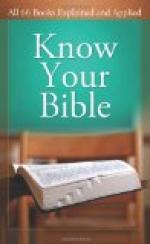Note. Find other scripture references to each of these occasions and become familiar with the name, date and import of each.
* * * * *
Chapter IV.
Sacred Institutions of Worship and Seven Great Covenants.
The Sacred Institutions of Worship.
1. The Alter. Make a careful study finding: (1) The first mention of it. (2) The different persons who are recorded as erecting altars, Gen. 1-Ex. 20. (3) The materials of construction, Ex. 20:24-25. (4) The purpose for which they were erected, including that of Joshua, Josh. 22:10, 22-29.
2. The Tabernacle, Ex. chs. 25-29. Study: (1) The instructions to build it, including the offerings and articles to be given. (2) Its furniture. (3) Its erection. (4) Its purpose, Ex. 29;42-45; Heb. Chs. 9-10. (5) Its history, when first set up, how long used, etc.
3. The Temple. (1) Solomon’s Temple. Study David’s desire to build and his preparation for it. 2 Sam. 7:1-2; 2 Chron. 28, 29; its material, erection and dedication, 1 Kings 5-8; 2 Chron. 2:6; its destruction by Nebuchadnezzar’s general, 587 B. C. (2) Zerubbabel Temple. Study the decree of Cyrus, return of the Jews, rebuilding and dedication, Ezra Chs. 1-6; its destruction by Pompey 63 B. C. and by Herod the Great 37 B. C. (3) Herod’s Temple. It was begun 20 or 21 B. C., John 2:20; Matt. 24:1-2; Matt. 13:1-2; Lu. 21:56, and destroyed under Titus, A. D. 70.
4. The Synagogue. Greek work meaning an assemblage. There were synagogues wherever there were faithful Jews, about 1500 in Palestine and perhaps 480 in Jerusalem. The officers were (1) Ruler. Lu. 8:49; 13:14; Mk 5:15, etc; (2) Elders, Lu. 7:3; Mk. 5:22, etc; (3) Minister, Lu. 4:20. The service was one of prayer and reading and expounding the scriptures. It was through the worship at the synagogue that the apostles everywhere had opportunity to teach Christianity.
5. The Church. The word means an assemblage and is most commonly used of a local congregation of Christian workers. It is sometimes called the church of Christ, Church of God, Saints, etc. Churches were established in cities and in homes. It is not proper to call all the Christians of a particular denomination a church. Nor can we call all of any denomination in a given territory a church. It would be wrong to say the Baptist church of the south. In the New Testament we can get a rather clear idea of it as an institution by a study of a few principal churches and leaders of the Christian movement after the ascension of Christ.
The Seven Great Covenants. There are two kinds of covenants. (1) Declarative or unconditional, example, Gen. 9-11, “I will.” (2) Mutual or conditional, example, “If thou wilt.” All scripture is a development of or is summed up in seven covenants.
1. The Adamic Covenant, Gen. 3:14-19. Outline the elements of the covenant, showing the persons affected and the results or conditions involved.




